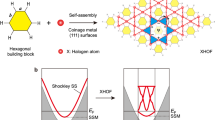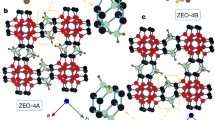Abstract
Following their discovery1, carbon nanotubes have attracted interest not only for their unusual electrical and mechanical properties, but also because their hollow interior can serve as a nanometre-sized capillary2,3,4,5,6,7, mould8,9,10,11 or template12,13,14 in material fabrication. The ability to encapsulate a material in a nanotube also offers new possibilities for investigating dimensionally confined phase transitions15. Particularly intriguing is the conjecture16 that matter within the narrow confines of a carbon nanotube might exhibit a solid–liquid critical point17 beyond which the distinction between solid and liquid phases disappears. This unusual feature, which cannot occur in bulk material, would allow for the direct and continuous transformation of liquid matter into a solid. Here we report simulations of the behaviour of water encapsulated in carbon nanotubes that suggest the existence of a variety of new ice phases not seen in bulk ice, and of a solid–liquid critical point. Using carbon nanotubes with diameters ranging from 1.1 nm to 1.4 nm and applied axial pressures of 50 MPa to 500 MPa, we find that water can exhibit a first-order freezing transition to hexagonal and heptagonal ice nanotubes, and a continuous phase transformation into solid-like square or pentagonal ice nanotubes.
This is a preview of subscription content, access via your institution
Access options
Subscribe to this journal
Receive 51 print issues and online access
$199.00 per year
only $3.90 per issue
Buy this article
- Purchase on Springer Link
- Instant access to full article PDF
Prices may be subject to local taxes which are calculated during checkout




Similar content being viewed by others
References
Iijima, S. Helical microtubules of graphitic carbon. Nature 354, 56–58 (1991).
Pederson, M. R. & Broughton, J. Q. Nanocapillarity in fullerene tubules. Phys. Rev. Lett. 69, 2689–2692 (1992).
Ajayan, P. M. & Iijima, S. Capillarity-induced filling of carbon nanotubes. Nature 361, 333–334 (1993).
Dujardin, E., Ebbesen, T. W., Hiura, H. & Tanigaki, K. Capillarity and wetting of carbon nanotubes. Science 265, 1850–1852 (1994).
Tsang, S. C., Chen, Y. K., Harris, P. J. F. & Green, M. L. H. A simple chemical method of opening and filling carbon nanotubes. Nature 372, 159–162 (1994).
Ugarte, D., Chatelain, A. & de Heer, W. A. Nanocapillarity and chemistry in carbon nanotubes. Science 274, 1897–1899 (1996).
Kiang, C. H., Choi, J. S., Tran, T. T. & Bacher, A. D. Molecular nanowires of 1 nm diameter from capillary filling of single-walled carbon nanotubes. J. Phys. Chem. B 103, 7449–7451 (1999).
Ruoff, R. S. et al. Single crystal metals encapsulated in carbon nanoparticles. Science 259, 346–348 (1993).
Guerret-Piecourt, C., Le Bouar, Y., Loiseau, A. & Pascard, H. Relation between metal electronic structure and morphology of metal compounds inside carbon nanotubes. Nature 372, 761–764 (1994).
David, V. P. et al. Controlled-size nanocapsules. Nature 374, 602 (1995).
Meyer, R. R. et al. Discrete atom imaging of one-dimensional crystals formed within single-walled carbon nanotubes. Science 289, 1324–1326 (2000).
Ajayan, P. M., Stephan, O., Redlich, P. & Colliex, C. Carbon nanotubes as removable templates for metal oxide nanocomposites and nanostructures. Nature 375, 564–567 (1995).
Dai, H. et al. Synthesis and characterization of carbide nanorods. Nature 375, 769–772 (1995).
Han, W., Fan, S., Li, Q. & Hu, Y. Synthesis of gallium nitride nanorods through a carbon nanotube-confined reaction. Science 277, 1287–1289 (1997).
Fan, X. et al. Atomic arrangement of iodine atoms inside single-walled carbon nanotubes. Phys. Rev. Lett. 84, 4621–4624 (2000).
Ball, P. New horizons in inner space. Nature 361, 297 (1993).
Stanley, H. E. in Introduction to Phase Transitions and Critical Phenomena 2 (Oxford Univ. Press, New York, 1971).
Lobban, C., Finney, J. L. & Kuhs, W. F. The structure and ordering of ices III and V. J. Chem. Phys. 112, 7169–7180 (2000).
Hamada, N., Sawada, S. & Oshiyama, A. New one-dimensional conductors—graphitic microtubules. Phys. Rev. Lett. 68, 1579–1581 (1992).
Koga, K., Parra, R. D., Tanaka, H. & Zeng, X. C. Ice nanotubes: What does the unit cell look like? J. Chem. Phys. 113, 5037–5040 (2000).
Goto, K., Hondoh, T. & Higashi, A. Determination of diffusion coefficients of self-interstitials in ice with a new method of observing climb of dislocations by X-ray topography. Jpn J. Appl. Phys. 25, 351–357 (1986).
Gao, G. T., Zeng, X. C. & Tanaka, H. The melting temperature of proton-disordered hexagonal ice: A computer simulation of TIP4P model of water. J. Chem. Phys. 112, 8534–8538 (2000).
Jorgensen, W. L. et al. Comparison of simple potential functions for simulating liquid water. J. Chem. Phys. 79, 926–935 (1983).
Steele, W. A. Interaction of Gases with Solid Surfaces (Pergamon, Oxford, 1974).
Rapaport, D. C. The Art of Molecular Dynamics Simulations (Cambridge Univ. Press, Cambridge, 1997).
Acknowledgements
K.K. and H.T. are supported by the Japan Society for the Promotion of Science (JSPS), the Japan Ministry of Education, and Institute of Molecular Science. X.C.Z. is supported by the US National Science Foundation and Office of Naval Research, and by a JSPS fellowship.
Author information
Authors and Affiliations
Corresponding author
Rights and permissions
About this article
Cite this article
Koga, K., Gao, G., Tanaka, H. et al. Formation of ordered ice nanotubes inside carbon nanotubes. Nature 412, 802–805 (2001). https://doi.org/10.1038/35090532
Received:
Accepted:
Issue Date:
DOI: https://doi.org/10.1038/35090532
This article is cited by
-
Schrödinger operators on ice-nanotubes with the delta vertex conditions
Quantum Studies: Mathematics and Foundations (2023)
-
Two-dimensional monolayer salt nanostructures can spontaneously aggregate rather than dissolve in dilute aqueous solutions
Nature Communications (2021)
-
The effect of an electric field on ion separation and water desalination using molecular dynamics simulations
Journal of Molecular Modeling (2021)
-
Confined water-mediated high proton conduction in hydrophobic channel of a synthetic nanotube
Nature Communications (2020)
-
Sponge-templating synthesis of sandwich-like reduced graphene oxide nanoplates with confined gold nanoparticles and their enhanced stability for solar evaporation
Science China Materials (2020)
Comments
By submitting a comment you agree to abide by our Terms and Community Guidelines. If you find something abusive or that does not comply with our terms or guidelines please flag it as inappropriate.



